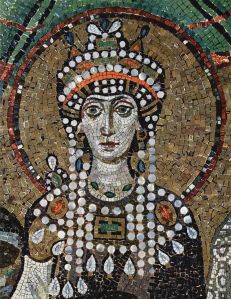Many adverts would have you think that freckles and other spots are an issue you should solve. Other adverts will tell you to celebrate the unique beauty of your skin. In either case, they will try to flog some concoction. I personally believe that the only care your skin needs is proper hydration (which will reduce the appearance of blemishes), which can be achieved with very simple ingredients. Those ingredients might be expensive (Shea butter is not cheap), but they do not need to be priced exorbitantly.
Trying to get rid of freckles and other blemishes is nothing new. In the first century CE, the Roman encyclopaedist Celsus wrote that ‘To treat pimples, freckles and spots is almost ridiculous, yet women cannot be torn away from caring for their appearance’ (On Medicine 6.5). Blaming women for an obsessive interest in their looks was an ancient leitmotiv. Of course, it is all rhetoric: men too were great consumers of cosmetics in the ancient world.
Recipes to remove freckles abound in ancient medical literature. Here I have chosen one transmitted by Aetius (sixth century CE), one of my favourite medical authors. Aetius may have been physician to the emperor Justinian, whose wife was Theodora, a rather colourful historical character. According to the historian Procopius (in the Secret History), Theodora was a child-harlot, known for her sexual prouesses. She went on to seduce the emperor and fully corrupt him. It is very tempting to imagine Theodora using the numerous cosmetic recipes listed in Aetius’ work.
Aetius has several recipes against freckles. The following caught my attention:
Another remedy against ephelides: works well. Soak entire eggs in vinegar, until the shell becomes soft. And piercing from the top, take out the white and mix with chopped Illyrian iris and the smoothest black cumin and frankincense, of each the same amount; crush together and add the right amount of honey, as mentioned before. When the affliction has become permanent, one has to use peels [that is, remedies that peel off the skin]. Aetius 8.12
I had to give this a try, with the help of my little assistant Big Boy T. We placed one egg in vinegar and left it outside for approximately 12 hours. I could perhaps have left it there a bit longer, but I did not want the shell to dissolve too much. This was a very good practical lesson in chemistry by the way. I have no idea why the egg has to be placed in vinegar – perhaps so that the vinegar imparts some of its powers onto the egg?
After piercing the egg and removing the white, we put one spoonful each of orris root (already crushed), nigella seed (which the ancients called black cumin), and frankincense. Orris root and nigella are easy to find, but I had to do a bit of online digging to find some frankincense! T had good fun crushing the ingredients and mixing them to the egg. We then added a big dollop of honey – it is always difficult to determine what ‘the right amount’ means in ancient recipes. We ended up with a preparation which, according to T, looked like vomit. Personally, I would be very concerned if my vomit was that colour! The smell of the preparation was not unpleasant, but none of us was particularly tempted to put it on our skin.
So how was this remedy supposed to work? Apart from nigella, each of the ingredients listed in Aetius’ recipe was – and still is – commonly used in cosmetic preparation. They may well have some mild effect on the skin, but I very much doubt they would remove freckles. On the other hand, they may offer some protection against sun damage – if that damage has not yet occurred. I suspect, however, that from an ancient medicine point of view, the important ingredient here is nigella. Nigella imparts a black colour to the preparation. In an ancient system of medicine, opposites were meant to cure opposites: a black preparation would treat black spots on an otherwise white skin.


One compound found in some quantity (up to about 0.33%?) in Nigella seed is thymoquinone. This compound shows quite a functional similarity to the oxidised form (1,4-benzoquinone) of the controversial skin-whitener hydroquinone. The oxidation/reduction of these quinones occurs easily at physiological conditions and some small fraction of thymohydroquinone is thought to be present in the seeds (adding another 0.03% to the figure I gave above). The ease of the conversion between thymoquinone and thymohydroquinone makes it difficult to be certain of that ratio.
Many plants contain antioxidants that are capable of reducing other compounds, it would be interesting to know the redox potential of that mixture you made.
I think you should find someone who is prepared to experiment with their freckles, though there is a possibility of nasty side-effects if it is as effective as hydroquinone.
Relevant research articles: http://www.hoajonline.com/journals/pdf/2052-9341-1-1.pdf
http://www.ncbi.nlm.nih.gov/pmc/articles/PMC3933240/
http://www.sciencedirect.com/science/article/pii/S030441650700298X
http://www.ncbi.nlm.nih.gov/pubmed/17364941
http://www.ncbi.nlm.nih.gov/pubmed/11979510
LikeLike
Thank you for such a thorough and useful comment! I don’t think I’ll inflict this concoction on anyone but I’ll certainly read the articles you suggested.
LikeLike
Pingback: Whewell’s Gazette: Vol. #33 | Whewell's Ghost
Pingback: History A'la Carte 3-26-15 - Random Bits of Fascination